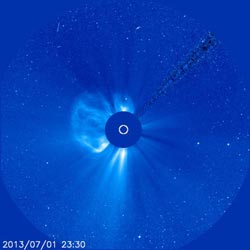Coronal Mass Ejection Headed Toward Mercury and Venus

On July 1, 2013, the sun erupted with a coronal mass ejection, or CME – shown here as the lighter-colored gas moving off to the left -- which soared off in the direction of Venus and Mars. This image was captured by the joint ESA/NASA Solar and Heliospheric Observatory. <br>Image Credit: ESA and NASA/SOHO<br>
Experimental NASA research models based on NASA’s Solar Terrestrial Relations Observatory show that the CME was not Earth-directed and it left the sun at around 570 miles per second.
The CME may, however, pass by NASA’s Messenger, Spitzer and STEREO-B satellites, and their mission operators have been notified.
There is only very slight particle radiation associated with this event, which is what would normally concern operators of interplanetary spacecraft, because the particles can trip computer electronics aboard interplanetary spacecraft.
If warranted, operators can put spacecraft into safe mode to protect the instruments from the solar material.
NOAA's Space Weather Prediction Center (http://swpc.noaa.gov) is the U.S. government's official source for space weather forecasts, alerts, watches and warnings.
Updates will be provided as needed.
Karen C. Fox
NASA's Goddard Space Flight Center, Greenbelt, Md.
Media Contact
All latest news from the category: Physics and Astronomy
This area deals with the fundamental laws and building blocks of nature and how they interact, the properties and the behavior of matter, and research into space and time and their structures.
innovations-report provides in-depth reports and articles on subjects such as astrophysics, laser technologies, nuclear, quantum, particle and solid-state physics, nanotechnologies, planetary research and findings (Mars, Venus) and developments related to the Hubble Telescope.
Newest articles

Webb captures top of iconic horsehead nebula in unprecedented detail
NASA’s James Webb Space Telescope has captured the sharpest infrared images to date of a zoomed-in portion of one of the most distinctive objects in our skies, the Horsehead Nebula….

Cost-effective, high-capacity, and cyclable lithium-ion battery cathodes
Charge-recharge cycling of lithium-superrich iron oxide, a cost-effective and high-capacity cathode for new-generation lithium-ion batteries, can be greatly improved by doping with readily available mineral elements. The energy capacity and…

Novel genetic plant regeneration approach
…without the application of phytohormones. Researchers develop a novel plant regeneration approach by modulating the expression of genes that control plant cell differentiation. For ages now, plants have been the…





















